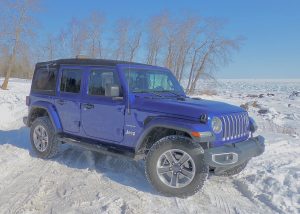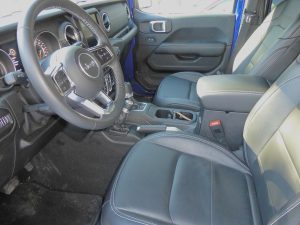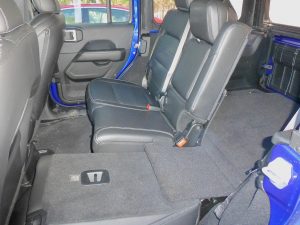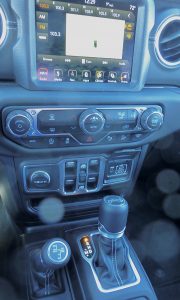New 2.0 Turbo Gives New Wrangler Huge Boost
By John Gilbert
The divide between vehicle buyers in the U.S. has been delineated for years by Jeeps: those who love ’em and those who hate ’em.
The ones who hate Jeeps may outnumber the fans, and they figure the Jeep outlived its usefulness in the face of the barrage of new and capable competitors throughout the industry. But there is nothing quite like the loyalty of those who love Jeeps, and who willingly put up with the nasty frequency of repair figures and pogo-stick bounciness that were nearly traditional in the past — all in the name of building no-compromise off-road conquerors.
Imagine the surprise of both extremes when they learn that the 2019 Jeep Wrangler has made a giant step toward the middle, adding refinement, comfort, sophistication, tech features, and a stunning new 2.0-liter turbocharged engine that leaves the V6 behind.
The Jeep Wrangler Unlimited Sahara 4×4 showed up for a week-long trest drive, in a stunning Ocean Blue Metallic Clearcoat color, looking good even when the paint was under a few layers of slush and road-treatment salt glop. This was a 4-door, with a fabric top that would be fun in the summertime because it has a sunroof and is removable. I didn’t try it with the wind-chill at 20-below.
The ride is refined to a point of comfort previously unimaginable in a Wrangler, as is every interior appointment and the fit and finish of fabrics and soft-touch surfaces, and high-tech features including the navigation system and screen, and all the connectivity outlets and controls.
It’s a sleight-of-hand trick. Where most SUVs pretend to be off-road worthy but bow to the Wrangler’s superiority off-road status. While remaining iunchallenged off-road, however, the new Wrangler can match the smooth on-road abilities of the contending SUV-wannabes.
The Wrangler sticker price is hefty, with the test Sahara starting at a base price of $38,295, and the Unlimited Sahara came so loaded with features and options that it stickered at $50,050.
Jeep and FCA have learned a lot from their fleet of more domesticated Jeeps such as the Grand Cherokee, Cherokee, Compass and even the Renegade. But instead of excluding the Wrangler from such sophistication, we must now focus on the transformation of the Wrangler, the Jeep that started it all as a rugged off-road vehicle during World War II. Critics accuse Jeep and its new owner, Chrysler and now FCA (Fiat Chrysler Automobiles) of not being aware that WWII ended.
But despite the similarities to the tradition and heritage of Jeeps long-since passed, it’s time to take another look at the Jeep Wrangler. Best to look at a 2019, but the new generation platform with its high-strength steel, plus its new engine and interior features, mostly hit the showrooms for 2018, so if you find a good deal on a 2018, grab it. Prepare to be impressed, with either model. Especially if you had some experience with its more primitive predecessors and haven’t seen what the late Sergio Marchione championed in his managerial renovation of the Jeep lineup.
With SUVs taking over the marketplace these days, most SUV buyers are looking for smooth comfort as well as the utility of all-wheel drive, and they’ve lost complete touch with the rugged, outdoorsy challenges of true SUVs. The biggest surprise for consumers, however, is that in reversing roles, the new Jeeps have all been sophisticated in ride and feature refinement, while losing none of its off-road capabilities.
Motor Trend magazine ignored the raft of new crossovers and chose the year-old body-on-frame Jeep Wrangler as its “SUV of the Year” for 2019. That came out two months after the same magazine said in its SUV capsules that the Wrangler was “unchanged” for 2019 because all the changes had been made for 2018, except for adaptive cruise, emergency braking and forward collision warning.
Those are far beyond the vehicle’s history, which still dictates the braided straps securing the doors from flying open too far.
The new Wrangler Unlimited Sahara 4×4 I test drove for a week in subzero cold and foot-deep snow along the North Shore of Lake Superior in February seemed eager to take on the nasty conditions but also insisted on carrying us in smooth on-road comfort, with supportive bucket seats up front and the 60-40 rear seats that conveniently fold down to allow storage of long items.
There are places, such in the Rocky Mountain High Country or the remote areas of Moab in Utah that you can only get into, or out of, with a Jeep. A precious few Land Rovers might do it too, but if you are lucky enough to take a guided trek into those most-remote areas, the tour guide will be in a Jeep, and you will be astounded at how it can seemingly defy gravity to get to some of those places.
So everyday driving, with occasional ventures into the woods or wilderness, are child’s play for such an over-engineered vehicle that has risen far above the level of expensive boy-toy.
It’s fun to note the upgrades, because designers have worked to fit them in without disrupting the traditional look of the seven-slotted grille. The round headlights, for example, now house narrow, rectangular LED headlights that use the roundness as a reflector to illuminate the road ahead. The test Jeep also had LED taillights, foglight, and daytime running lights as part of a thousand-dollar LED package.
Perhaps the greatest upgrade is under the hood, where a sensational 2.0-liter 4-cylinder “eTorque” engine resides in all its turbocharged splendor. Yes, you can still get a potent V6, the 3.6-liter Pentastar, with 285 horsepower and 260 foot-pounds of torque, but this new and impressive direct-injection turbo four has 280 horsepower (almost as much) and 306 foot-pounds of torque (far more). Everytime I gave anyone a ride in the Wrangler, the passenger couldn’t believe it was churning out all that power with a 2.0-liter four.
Underneath, the new generation Wrangler feels totally secure with a strengthened platform and upgraded suspension. Jeeps can now be selected for whatever your intended driving might be. So you’ll want to choose your specific favorite carefully to make sure you get the right 4-wheel-drive system, engine, transmission and suspension, all varying by model. The Sahara with its 2.0 Turbo comes with a new ZF 8-speed automatic transmission, and Selec-Trac all-wheel drive with a shiftable lever for low or high, 2- or 4-wheel drive, replacing the standard Command-Trac part time unit. It also is tuned for a little more comfort out of its suspension, which doesn’t intrude a bit on its ability or eagerness to go charging off through foot-deep snowfalls or serious off-roading ventures.
It also has hill-descent control, and thoroughly modern stuff like electronic stability control, electronic roll mitigation, trailer sway damping, ParkView backup camera, voice commands for the Bluetooth connections, blind-sport and cross-path detection, Apple CarPlay, and, just in case you suspect it’s gotten too fancy, it has skid plates underneath the fuel tank, transmission and transfer case so you can listen to audio stuff while careening over rocks or rugged off-road terrain.
The much more solid feel, the power of the potent new engine, and the comfort and appeal of the vastly upgraded interior might give you a shock every time you stop and climb out, then look back and realize it has retained that old familiar Jeep Wrangler look. This is not a pretender of any fashion; it’s a Jeep Wrangler that still outdoes other off-roaders and now can match any of them on-road or in high-fashion settings.







 John Gilbert is a lifetime Minnesotan and career journalist, specializing in cars and sports during and since spending 30 years at the Minneapolis Tribune, now the Star Tribune. More recently, he has continued translating the high-tech world of autos and sharing his passionate insights as a freelance writer/photographer/broadcaster. A member of the prestigious North American Car and Truck of the Year jury since 1993. John can be heard Monday-Friday from 9-11am on 610 KDAL(www.kdal610.com) on the "John Gilbert Show," and writes a column in the Duluth Reader.
John Gilbert is a lifetime Minnesotan and career journalist, specializing in cars and sports during and since spending 30 years at the Minneapolis Tribune, now the Star Tribune. More recently, he has continued translating the high-tech world of autos and sharing his passionate insights as a freelance writer/photographer/broadcaster. A member of the prestigious North American Car and Truck of the Year jury since 1993. John can be heard Monday-Friday from 9-11am on 610 KDAL(www.kdal610.com) on the "John Gilbert Show," and writes a column in the Duluth Reader.